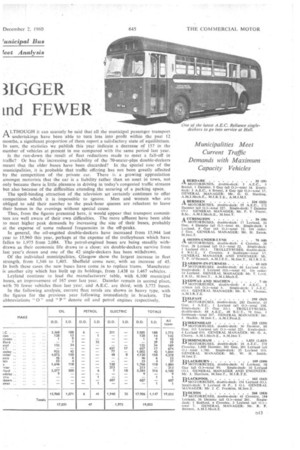3IGGER aid FEWER
Page 55

If you've noticed an error in this article please click here to report it so we can fix it.
ALTHOUGH it can scarcely be said that all the municipal passenger transport undertakings have been able to turn loss into profit within the past 12 months, a significant proportion of them report a satisfactory state of equilibrium. In sum, the statistics we publish this year indicate a decrease of 157 in the number of vehicles at present in use compared with the same period last year.
Is the run-down the result of fleet reductions made to meet a fall-off in traffic? Or has the increasing availability of the .70-seater-plus double-deckers meant that the older buses have been discarded? In the special case of the municipalities, it is probable that traffic offering has not been greatly affected by the competition of the . private car. There is a growing appreciation amongst motorists that the car is a liability rather than an asset in town, not only because there is little.pleasure. in driving in'today's congested traffic streams but also because of the difficulties attending the securing of a parking space.
The spell binding attraction of the television set certainly continues to offer competition which it is impossible to ignore. Men and women who are obliged to add their number to the peak-hour queues are reluctant to leave their homes in the evenings without special cause.
Thus, from the figures presented here, it would appear that transport committees are well aware of their own difficulties. The more affluent have been able to meet higher peak demands by increasing the size of their buses, probably at the expense of some reduced frequencies in the off-peaks.
In general, the oil-enghled double-deckers have increased from 15,944 last year to 15,960 this year, perhaps at the expense of the trolleybuses which have fallen to 1,975 from 2,084. The petrol-engined buses are being steadily withdrawn as their economic life draws to a close: six double-deckers survive from last year's dozen and one of the 42 single-deckers has been withdrawn.
Of the individual municipalities, Glasgow show the largest increase in fleet strength, from 1,346 to 1,405. Sheffieldcome next, with an increase of 45. In both these cases the new buses have come in to replace trams. Manchester is another city which has built up its holdings, from 1,438 to 1,467 vehicles, ,
Leyland continue to lead the manufacturers' table, with 6,100 municipal buses, an improvement of 167 over last year. Daimler remain in second place, with 70 fewer vehicles than last year, and A.E.C. are third, with 3,773 buses.
In the following analysis, current fleet totals are shown in heavy type, with the figures for the previous year following immediately, in brackets. The abbreviations "0" and "P" denote oil and petrol engines respectively.




















































































































